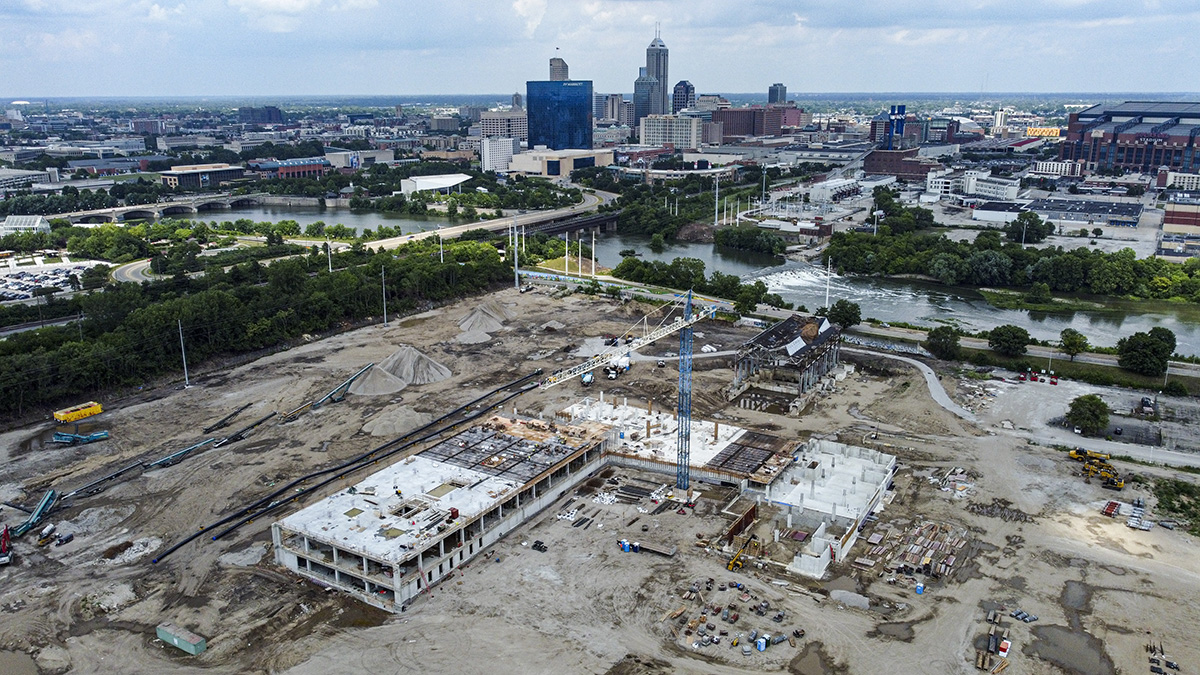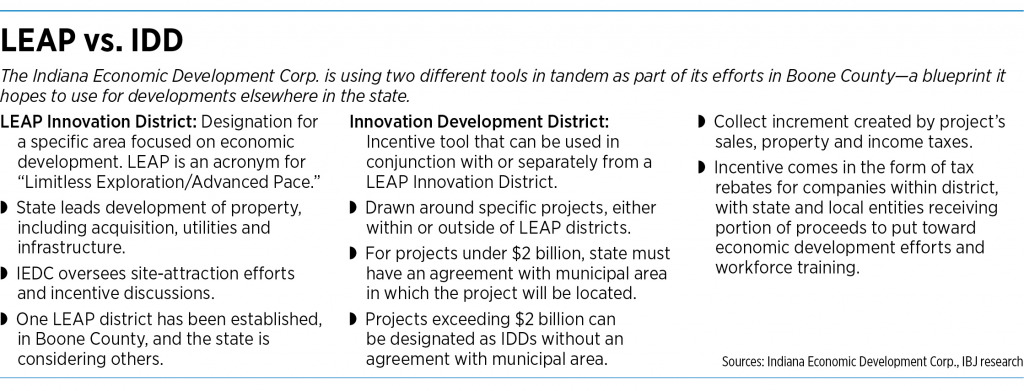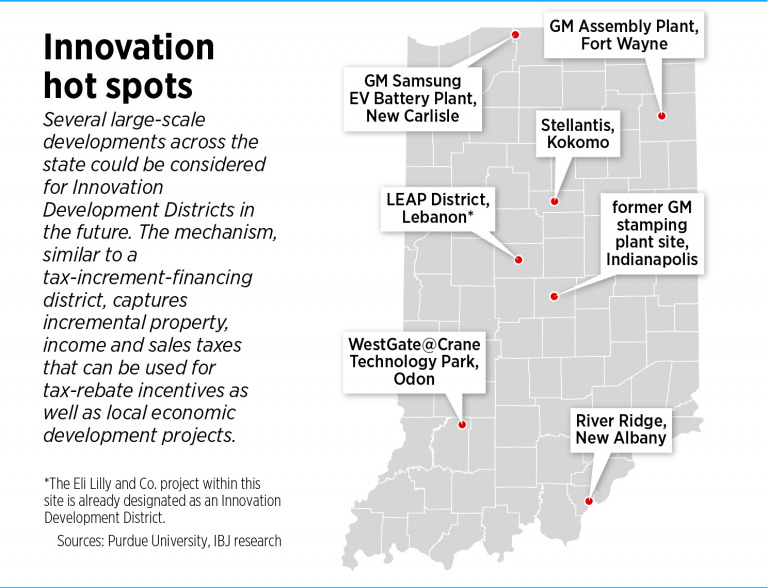State considers adding LEAP districts beyond Lebanon
Subscriber Benefit
As a subscriber you can listen to articles at work, in the car, or while you work out. Subscribe Now
The LEAP Lebanon Innovation and Research District under development in Boone County represents a shift in the way the state is working to attract companies and create jobs. The change is meant to help Indiana compete for the nation’s biggest high-tech economic development opportunities.
Rather than letting local governments take the lead in planning a shovel-ready project that the state would then market, with LEAP, the Indiana Economic Development Corp. has taken on the responsibility for acquiring land and master-planning the site.
Now, state officials are considering whether to use the Lebanon LEAP as a blueprint for additional commercial and industrial parks across the state.
The quasi-governmental IEDC already has its eye on a few sites officials believe could benefit from the model. Chief among them is the former General Motors stamping plant site along the White River in downtown Indianapolis, where the state previously purchased about 90 acres as part of a deal to land Elanco Animal Health’s $150 million headquarters.
IEDC officials say they’re also looking elsewhere for opportunities to deploy the LEAP concept, as well as separate tools like single-project Innovation Development Districts that allow the state to capture state and local revenue to fund improvements and incentives at the sites.
“Obviously, Boone County and Lebanon is our initial step into this space, but we are evaluating other opportunities around the state and in hand with our local partners to identify whether there could be additional LEAP developments of varying sizes,” said Mark Wasky, senior vice president of community affairs at the IEDC.
“Whether those are smaller developments like on the near-west side of Indianapolis, with the former GM stamping plant, or something more substantial like the effort in Boone County, we haven’t identified or landed on a specific location for the next district or districts,” Wasky said. “But it is something that we are continuing to take a look at to ensure that we have sites that are ready to go when businesses interested in investing in Indiana come knocking.”
Setting the stage
The Boone County LEAP district is entertaining a potential investment pipeline of $56 billion.
Indianapolis-based Eli Lilly and Co. has already committed to spend $3.7 billion to build two advanced manufacturing facilities on the campus, and in recent weeks the IEDC said the site is in the running for a $50 billion semiconductor plant and a separate, $3.2 billion data center.
If the IEDC lands those two projects, it would more than double the $22 billion in capital investment commitments the state secured in all of 2022—its best year on record.
Across Indiana, more than $100 billion in potential investment is being considered but is not committed, officials say.
The IEDC is hopeful it can use the LEAP model as a springboard for growing that investment figure by better competing against other states that have won recent big projects—like a $20 billion Intel chip plant that broke ground in Ohio last year—because they had land ready for projects or were able to secure it quickly.
In Boone County, the IEDC has secured roughly 9,000 acres for LEAP—which stands for Limitless Exploration/Advanced Pace—and designated different areas for renewable-energy projects, shovel-ready development, research and development, and even a mixed-use village concept. State officials have compared LEAP to the Research Triangle Park in North Carolina.
“Now that people know that there is a mega-site, shovel-ready development that’s going on—that has the zoning, the utilities, the infrastructure—I think it’s only going to continue to garner interest,” said David Rosenberg, IEDC’s chief operating officer.
He told IBJ that acquiring land and adding those shovel-ready components would be key to fostering development in other areas of the state.
Among the sites that could be considered for LEAP projects are WestGate@Crane near the Naval Surface Warfare Center in Martin County and the River Ridge Commerce Center in Clark County. WestGate@Crane is one of the state’s fastest growing technology centers, while River Ridge is an established, county-developed site that is adjacent to the Port of Indiana on the Ohio River in Jeffersonville.
In addition, the state could consider using LEAP or the Innovation Development District designation to benefit or expand what are now singular developments, including the $2.5 billion Stellantis and Samsung SDI project in Kokomo or the $3.5 billion General Motors electric vehicle battery facility announced last month in St. Joseph County.
The state is also considering more ground-up developments, similar to what’s underway in Boone County.
Victor Smith, a Bose McKinney & Evans LLP partner and a former state secretary of commerce, said as long as the LEAP model is effective for attracting companies, the state will stick with the approach.
But he expects that, if the state were to move ahead with other LEAP sites, it would put out a call to regions across the state asking for proposals, rather than making a selection unilaterally as it did in Boone County.
“It could put it to the regions to say, ‘If you want to be relevant, show [us] your relevance,’” Smith said. Still, he said, it’s unlikely the state would try to juggle a handful of districts at once.
Jenny Massey, director of site selection and incentives for Chicago-based Sikich LLP, agreed. She said the IEDC’s approach to considering placement of LEAP districts in other parts of the state is a sensible one but it should be flexible.
“Each proposed LEAP district should be unique and require a tailored approach that considers regional advantages and economic goals,” Massey said. “Whether or not the GM stamping plant should be a LEAP district will depend on a thorough assessment and engagement with industry and the local community. However, it seems like it would be a great opportunity for revitalization.”
LEAP on the White River?
Wasky said the former GM stamping plant is of particular interest because it meshes with the goals of LEAP in that it’s already under state control and is a master-planned-style development focused on cutting-edge industries.
The site is only a fraction of the size of the Boone County LEAP. But its location on the western edge of downtown Indianapolis and near amenities like the Indianapolis Zoo and White River State Park gives it its own advantages.
The state in recent months has been workshopping new marketing monikers for the stamping plant site, with Xcel Indy considered, along with a more formal name that is now in regular use by the city: the White River Innovation District.
During the week of the Indianapolis 500, the IEDC offered helicopter tours to give prospective users views of both the LEAP district in Lebanon and the stamping plant site. The state declined to share details about who was invited to participate in the tours, citing confidentiality for prospective business deals.
So far, city officials say they’ve had no formal conversations with the state about designating the stamping plant site as a LEAP.
But in coordination with Greenfield-based Elanco—which is using 40 acres at the 90-acre site—state and local officials have said they are seeking to create a research and development campus focused on biosciences and animal health companies. Aspirations for the remaining 50 acres of the site include office space, housing, retail and other components.
Scarlett Andrews, the city’s deputy mayor for economic development, said the city would be open to a LEAP or Innovation Development District designation if the state were to go in either direction.
“We’re on the same page” as the IEDC about the future of the property, Andrews said.
“This is a large site that the IEDC owns and controls, so I think it’s natural that they will be thinking about bringing all the tools that they have at their disposal to bear on that site.”

Another tool in the toolbox
Aside from its LEAP strategy, the IEDC has an ever-growing economic development toolbox. Among the most pivotal when it comes to megadeals—generally anything exceeding $1 billion in capital investment—is the Innovation Development District designation created in 2022 through state legislation.
Innovation Development Districts allow the state to draw boundaries around specific projects and capture incremental growth in income, sales and property taxes that result from the projects. That money can then be used to offer companies rebates for hitting target employment and production thresholds.
The Innovation Development Districts are similar to tax-increment-financing districts, except the latter are locally designated and controlled and capture local property tax revenue that can be used for incentives and improvements in the area.
The Innovation Development District would funnel most of the siphoned-off tax revenue to the state, which would control how it’s spent, with a much smaller portion designated for local governments.
Last year, when the Legislature debated and then approved the districts, advocacy organizations working on behalf of local governments expressed concern that the IEDC was being given too much latitude to create the districts without requiring much public input. The legislation was later amended to require that at least 12% of tax revenue captured by the district revert back to the local tax base.
“I think there are decision points where locals will inherently have participation because, to create a project of that size, there needs to be collaboration,” said Ryan Hoff, director of government affairs and general counsel for the Association of Indiana Counties.
The Lilly project at LEAP Lebanon is expected to be the state’s first Innovation Development District, with up to $271 million in tax rebates for the company’s investment, which is the single-largest incentive ever given by the IEDC.
All the sites the state might consider for LEAP-like projects could ostensibly have projects within them that are considered for Innovation Development District designations, as well.
But a project doesn’t need to be within a LEAP district to qualify for the designation. And the incentive can be paired with others—including redevelopment tax credits, training grants or EDGE credits—to sweeten the deal for would-be users.
Howard County officials worked with the IEDC to develop a state-led incentive package totaling $445 million for Stellantis, which has since moved the operation into a holding company called StarPlus Energy LLC. The package includes $187 million in direct benefits for the company across varying incentive types, along with $258 million in redevelopment tax credit loans for infrastructure and other to-be-determined uses.
The state created the incentive package for Stellantis before the IEDC had the authority to create an Innovation Development District. But Rosenberg and others at IEDC said the district is an option for continuing the development of that site in the future.
“We would definitely be open to that conversation with the state,” Kokomo Mayor Tyler Moore told IBJ.
And even without the designation, the IEDC is in the early stages of acquiring land near the Stellantis site to market to suppliers and other companies within the electric vehicle battery ecosystem, multiple sources told IBJ.

Some skepticism
Economic development officials and outside observers say what makes LEAP and the Innovation Development District valuable is the state’s more direct involvement in site selection and a revenue source for funding incentives. Smith, the former commerce secretary, said that is a particular advantage for landing megadeals.
“There’s a lot of pent-up demand and a lot of big projects that are out there, especially in today’s reshoring world,” Smith said. “I think it’s a good idea because the scale of these megasites is almost too big for your traditional developer on a speculative basis to go put together—they’re just not going to go out and do that.”
While some economic development experts like Smith and Massey, the site selector, are in favor of the state’s taking a more active role in the site-attraction process, some municipal leaders are concerned their cities or counties could lose out on big deals because of the state’s vested interest in seeing its own sites succeed.
Fishers Mayor Scott Fadness told IBJ that as long as the state continues focusing on megadeals that wouldn’t fit his or other Hamilton County communities and are instead a better fit for the existing LEAP campus, he doesn’t take issue with the state’s strategy.
But he added it’s vital that the state not overuse tools like Innovation Development Districts, which would quash the role local entities traditionally play in incentive conversations.
“I think as long as Secretary Brad Chambers and the IEDC focus on these exceptionally large projects that require state resources, I don’t have a direct or immediate concern,” he said. “If we start to see where local communities are cut out of projects that are well within their abilities and means to deliver, then I think we would start to have … a problem in terms of swim lanes.”
Matthew Greller, CEO of Accelerate Indiana Municipalities, an organization that represents cities and towns across the state, said while some communities echo Fadness’ concerns about overstepping, most are supportive of the state’s efforts.
“We have to be patient,” he said. “This is an approach that has not been utilized in Indiana. Just the sheer magnitude of some of the jobs and some of the projects that the IEDC is announcing has to be pretty positive for the state as a whole. But we need to make sure we’re not taking away from areas that are seeking development on their own and growth on their own.”
